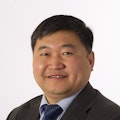Groups
Mae'r cynnwys hwn ar gael yn Saesneg yn unig.
Our research is led by internationally renowned researchers, including world experts in tight junctions, angiogenesis and metastasis.

Dr Jun Cai’s Group
The reciprocal signals between cancer cells and the surrounding microenvironment consist of diverse feedback loops that necessitate tumour evolution. The work carried out in Dr Cai’s group adopts a combination of in vitro and/or in vivo models with diverse functional assays to provide a powerful platform for the observation of cellular behaviour and the interactions within the tumour microenvironment.
Dr Cai’s group aims to develop synergistic therapeutic strategies in addition to the current treatment regimens for solid tumours, such as breast, colorectal and ovarian cancers.
Dr Yuxin Cui’s Group
The tumour microenvironment (TME) plays a critical role in tumour progression, metastasis and drug resistance. More effective targeted therapies against late-stage tumours may be developed after we gain deeper insight into tumour cell dynamics in tumour microenvironment.
Dr Cui’s group aims to identify the crucial signalling pathways which control the interaction between tumour cells and tumour microenvironment components, and to elucidate the mechanisms of tumour microenvironment-mediated selective tumour cell invasion and organ-specific metastasis.
Dr Dafydd Alwyn Dart’s Group
Prostate cancer is driven by the androgen receptor, which is the key signalling molecule in this disease. Prostate cancer cells require androgens for growth, and the mainstay of clinical therapies involve androgen ablation.
However, prostate cells may overcome this inhibition and patients can relapse with androgen independent disease - where the prostate cancer cells grow independently of androgens. There is no current successful therapy for this late stage.
Dr Dart’s group aims to understand the mechanisms of androgen independence and assess novel therapies aimed at overcoming this.
Dr Tracey Martin’s Group
Tight junctions (TJ) have become recognised as key players in cancer metastasis. Early studies suggested a link between the reduction of tight junction proteins and tumour differentiation and increasing experimental evidence has emerged to place tight junctions in the frontline as the structure that cancer cells must overcome in order to metastasize.
Dr Martin’s Group aims to understand the regulation of metastatic disease by tight junctions in order to identify targets for disease intervention, prognosis and diagnosis.
Dr Andrew Sanders' Group
The metastatic dissemination of cancer cells to secondary sites represent a serious health concern and are associated with poor patient prognosis.
Research within Dr Sanders’ group aims to identify mechanisms that facilitate and drive the dissemination of cancer cells and their establishment at these secondary foci, with particular interest in the mechanisms underlying the predisposition of prostate and breast cancer cells to establish bone metastasis. In this respect, research is focused on a number of key signalling pathways, their ability to influence these processes and their potential for therapeutic intervention.
Dr Lin Ye’s Group
Tumours comprise cancer cells, stroma cells, vascular endothelial cells, immune cells and extracellular matrix (ECM) etc. Cancer cells facilitate cross-talk with the ECM and other cells within the millieu foster a favorable microenvironment for them to survive, grow and spread at both primary and secondary tumour sites. These interactions are pivotal for cancer development, progression and metastases.
Dr Ye’s group aims to identify and develop markers/targets for early diagnosis, treatment and prevention of cancer by dissecting such cancer cell facilitated interactions with the tumour microenvironment:
- tumour cell-released bone morphogenetic proteins
- a transmembrane protein (CMG2) of cancer cells which mediates interaction and modification to the ECM
- tumour cell-secreted matrix proteins in cancer progression and metastasis.




